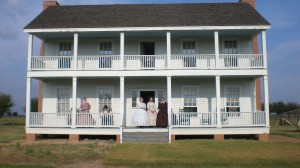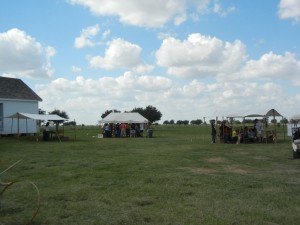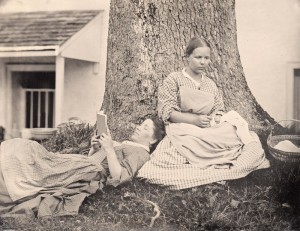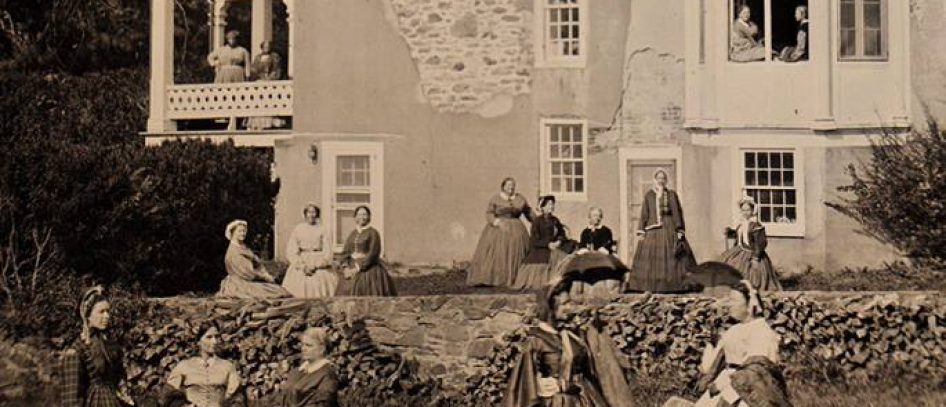 What are Living History Events?
What are Living History Events?
There are different types of living history events or activities in Texas; some more available than others. The following information is based on definitions developed by Elizabeth Stewart Clark on her website www.elizabethstewartclark.com and is used here with her permission.
“Smorgasbord” Events
Because there is not generally a time/place specific scenario link, the event participants and visitors have the flexibility of moving between multiple “zones” or mini-events within the larger venue. It’s possible to set up pockets of history-heavy interactions within the larger event. These pockets might involve, for instance, a “Back At Home” scenario of a military relief society working on aid projects to be sent to the front, or political speechmaking or public debates or even reading a period novel aloud.
It is possible to reach a very high standard of material culture accuracy at any event, and Smorgasbord style happenings are no different. Some willing suspension of disbelief is required (as with all events, really!), as some accommodations are made to history, in order to provide the logistical support for the event itself. For instance, canvas tents may be agreed to be “cottages.” Everyone may agree to overlook the ubiquitous Confessionals of Our Lady of the Blue Waters (because sanitation for large numbers is important!) Still, it is very possible, within a smaller group at the event itself, to set a material culture standard.
Smorgasbord events generally have a high level of public interaction. History-heavy set-ups within the larger event have fantastic “spark” potential—helping someone else have a Magic Moment that sparks their interest about the past, and gets them asking questions. There is a high public-education factor to consider, and also a very high intellectual burden to present the most accurate information possible.
 Living History Demonstrations
Living History Demonstrations
Demos can be found in multiple settings, from historic site interpretation to the large Smorgasbord event. With a demonstration, an individual or small group presents a specific historic aspect to the public. They may be demonstrating entirely, or may have an interactive set-up (allowing children to “wash” rags in cold water and hang them to dry, as part of a larger laundry demonstration, for instance). Demonstrations can also be helpful at “workshop” style events, where other living history enthusiasts are interested in adding to their historic skill or knowledge base.
The potential for a high level of public interaction is very good, but even shy persons can be included, providing background action, for instance, while a more talkative person takes an interactive role with visitors.
Demonstrations, whether closed or interactive, are another great “spark” method for public education.
Events with an Off Stage
Some event structures will have all participants focused on an interpretive or scenario goal during public hours, but may enjoy a very modern social scene in the evening. People may doff their period clothing and personas, bring out modern sweat pants, go to the pizza place, watch DVDs on a portable player in their tent—or just drink Pepsi from the can out in the open. At an event with Off Stage time, it’s expected that most people want to relax from the history aspect of the event, and enjoy some modern social time.
If the event participants all agree, this can be fun. If it’s not something you’d really enjoy, it’s worthwhile to ask event organizers about the availability of Off Stage or After Hours activities, so you have the fore-notice you may need to make an informed choice to attend or not, or to stay on site, or not. If an event has great daytime living history opportunities, but modern socializing at night, it might be an ideal event at which to turn Ramada Ranger—taking yourself off-site for the evening if you don’t wish to participate in modern camping or socializing after hours.
 Immersion
Immersion
Immersive situations are a little different from other Living History event types. Consider them “Lab” events or experimental archeology; a time for history enthusiasts to assemble their best information and material culture, and use them in an integrated fashion for the whole event span. The immersive event isn’t really for public edification. Interactions are first-person among all the participants for the entire event. After the event, they have a deeper understanding of how all the research really applies to everyday life, and can take that context back into public interactions at other event styles.
Immersion events tend to be very small compared to other event options. Generally, they are “closed” or by invitation only. Don’t let that scare you! To be extended an invitation for an open spot, the process is very easy: let the organizer know you’re interested, and amenable to the published event scenario and standards. Immersion events are generally given a lot of lead-time. It’s not unusual for the organizers to prepare two years ahead, and for participants to commit and begin their own preparations a year in advance of the event date.
Historic Site Interpretation
Historic sites are unique—they present a picture of a specific time and place, often with historic, restored, or replica buildings, material culture, and other interpreters. Each site has its own history to communicate, so a person stepping into site interpretation should be amenable to assisting in that goal, rather than trying to shoehorn their own agenda into the site. Good interpreters are well-rounded, understanding both the site’s history and people, as well as how everything fits into the broader context of “The World Of Mid-Century.”
Some sites require a specific interpretive voice, in an effort to have consistent presentations. This is not a bad thing! If you have been used to using only third person, and a site wishes you to do short presentations “in character”, it’s a great chance to learn more about a specific person (or specific generic-sort of person), and try new skills. If a site prefers third-person voice and interactions, they may have excellent reasons for doing so (one big factor is the decreased chance for melodrama that can sometimes devolve from un-skilled first person attempts).
Some sites may require a specific, rehearsed speech at each station. It can stand as a block to true interaction with site visitors. But often the scripts are written to prevent Docent Lore (historic site myths), or random off-the-cuff lecturing that doesn’t advance the site’s interpretive goal.
